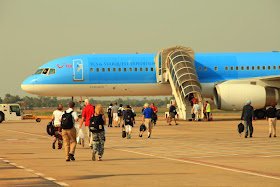My wife and I recently visited relatives for the holidays in southern California and to break up the monotony of eating way too much food and visiting with people in indoor (TV) settings, we took a trip to the Mojave Desert and the Blackhawk Landslide. Ever since I was made aware of this huge feature, I have wanted to see and visit it. The best way to view the slide is from the air and since we did not have our own plane or drone delivered by Santa Claus, I include images found on the web. My images taken on the ground during our visit are also shown after the aerial pictures.
 |
| View to the south of the Blackhawk slide - hummocky terrain in image center Photo credit: USGS web site: http://geomaps.wr.usgs.gov/archive/socal/geology/transverse_ranges/index.html |
 |
| Closer in view of the Blackhawk slide with the San Bernardino Mountains in the background Photo credit: Kerry Sieh. Image found on: http://www.lucernevalley.net/history/blackhawk.htm |
The thrust fault at the base of the northern San Bernardino Mountains is shown in the photo above. This upper block is composed of metamorphosed limestone and dolomite (marble) that is Pennsylvanian in age (about 300 Ma). These rocks correlate in time with the Supai Group in Grand Canyon and the Bird Springs Formation in the Mojave Desert. The thrusting pushes these relatively weak rocks out into open space in the Mojave Desert. Thus the Blackhawk slide is the consequence of rapid thrusting of weak rock that has collapsed into the desert.
 |
| Annotated image showing the Blackhawk slide and its source area in the San Bernardino MountainsPhoto credit: Kerry Sieh with annotations by Wayne Ranney |
We stopped on California Highway 247 to observe the distal end of the slide. It is the low hills on the skyline. The Blackhawk slide is about 5 miles long and 2 miles wide (8 km long and 3 km wide). It is between 30 and 100 feet thick (10 and 30 m thick).
Norm points out the slide with the western margin of the San Bernardino Mountains in the far distance.
We drove on a small mining road to the top of the slide. In the distance you can observe light colored disturbed areas where the Pennsylvanian age carbonates are being mined for cement.
Close-up view of the carbonate mine at the base of the San Bernardino Mountain. The thrust fault is below the lowest seen mine. Photo by Norm Meek.
Here is an exposure of the limestone on top of the slide. Note the original bedding which is still intact.
View to the north and the source area of the slide on Blackhawk Mountain. Note the light colored area beyond the closest yucca plants. This is where radiocarbon dates on freshwater (pond deposits) gastropod and pelecypod shells were obtained giving an age of about 17,400 + 550 years for the slide. Dr. Meek thinks that native carbon in the slide breccia may make this date too old and he suggests an age of around 14,000 years. It is interesting to speculate if the slide was purely from a gravitationally unstable overburden on the thrust. Or was it activated by seismic processes either from the thrust itself or movement on the San Andreas fault. Or was it facilitated by the pluvial Pleistocene climactic conditions at the time? Or could it be a combination of all three playing into its ultimate collapse?
The undisturbed upper surface of the slide looking northeast.
An small quarry on the northwest lobe of the slide provides both a view into the interior of the deposit and a blight on the slide. Shouldn't the geologic community petition for this feature to be set aside as an "Area of Special Geologic Interest?" It is located on BLM land and certainly there are other nearby areas to obtain gravel or marble for the construction business.
I enjoyed seeing an interior outcrop of the slide but the quarry looks to be a fair place for parties, trash disposal and general disrespect.
The wall of the quarry shows the near 100% composition of the clasts as Pennsylvanian marble. Helen and I enjoyed our short visit to the Blackhawk landslide. This is one of the largest such landslides that was mobile on a cushion of trapped air. It deserves to be protected and I hope you get to visit it one day. Happy 2015 everyone and thanks for reading!
Thanks to Dr. Norman Meek who took time out from his holiday to show us around. For a great outline of the geology of the San Bernardino Mountains, check out this USGS web page.
References
Woodford, A.O., and Harriss, T.F., 1928, Geology of the Blackhawk Canyon, San Bernardino Mountains, California: University of California Publications in Geologic Sciences, v. 17, p. 265-304.
Shreve, R.L., 1968, The Blackhawk landslide: Geological Society of America Special Paper 108, 47 p.
Shreve, R.L., 1987, The Blackhawk landslide, southwestern San Bernardino County, California: Geological Society of America Centennial Field Guide - Cordillera Section, v. 1, p. 109-114.




































